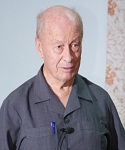| 个人简介 | |
|---|---|
 Prof. Dusan Berek Slovak Academy of Sciences,Slovakia |
|
| 标题: Recent progress in liquid chromatography of synthetic polymers | |
| 摘要: High performanceliquid chromatographic (HPLC) methods represent the most important tool for molecular characterization of synthetic polymers. Mean molar masses and molar mass distributions of linear and branched homopolymers are readily determined by size exclusion/gel permeation chromatography (SEC/GPC). As by-products, several other useful data can be assessed with SEC/GPC. Recent progress in SEC/GPC comprises improved instruments and data processing procedures. High sample through put of the ultra-fast SEC/GPC allows acceleration of analyses, which is especially important in combinatorial material chemistry and in production control. Still, further improvements of the SEC/GPC method are needed, which include its hardware, especially columns and detectors, and also standardization of sample preparation, measurement, and dataprocessing. SEC/GPC exhibits excellent intra-laboratory repeatability, which evokes a notion of its high reliability. Recent series of the round robin tests, however, revealed surprisingly poor inter-laboratory reproducibility of results. Evidently, accuracy of many SEC/GPC results may be rather limited. In most cases, SEC/GPC does not enable precise molecular characterization of complex polymer systems, which possess more than one dispersity (distribution) in their molecular characteristics. Typically, polymer mixtures, copolymers and functional polymers exhibit besides molar mass distribution also distribution in their chemical structure while e.g. stereoregular polymer species show also molecular architecture distribution. To assess above distributions, new HPLC procedures are developed. These are based on the controlled combinations of entropic (exclusion) and enthalpic (interaction) retention mechanismswithin the same HPLC column or in a series of independent separation systems. These approaches are denoted “coupledpolymer HPLC” and “two-, or multi-dimensional polymer HPLC”, respectively. Enthalpic retention mechanisms in HPLC of synthetic polymers include adsorption, partition, phase separation and ionic effects. We shall review recent progress and also inherent problems in SEC/GPC, as well as in coupled and two-dimensional polymer HPLC procedures, and outline anticipated future developments in these fields. Supported with project SAS-MOST JRP 2014-9, Synthesis of well-defined novel copolymers by use of living polymerization methods and advanced chromatography technique | |
| 简介: Graduated with an honour Master of Chemical Engineering from the Slovak Technical University in Bratislava. PhD Thesis at Polymer Institute, Slovak Academy of Sciences in Bratislava and Institute of Macromolecular Chemistry, Czechoslovak Academy of Sciences in Prague. DSc Thesis at Slovak Technical University Bratislava. Employed at Polymer Institute, Slovak Academy of Sciences (PI SAS) in Bratislava since 1960. 1992-1995 served as elected member of the Presidium of the Slovak Academy of Sciences. Served as Chairman of the Czecho-Slovak and Slovak National Committee of Chemistry for the International Union of Pure and Applied Chemistry, as Member of the Board of the Federation of European Chemical Societies, as well as the President of the Slovak Chemical Society. Corresponding member of the Central European Academy of Sciences and member of the Learned Society of the Slovak Academy of Sciences. Former titular member of IUPAC Polymer division and Chairman of Subcommittee of molecular chararacterization of synthetic polymers. Topics: Thermodynamics and hydrodynamics of multicomponent polymer systems; liquid chromatography of synthetic polymers - author of five original methods for separation of complex polymer systems; preparation and application of microporous carbon fibers. Author or co-author of two monographs on liquid chromatography and 300+ scientific papers in extenso published in refereed periodicals (200+ in the Current Contents covered Journals), and in proceedings and chapters of books, as well as 60+ patents (four of them were licensed) - cited more than 3,000 times in SCI journals and monographs. Presented over one hundred and twenty invited plenary, key-note and main lectures, as well as over 900 lectures, short communications and poster contributions during congresses, symposia and conferences, as well as during lecturing tours to over fourty countries. Elected „Slovak scientist of the year 1999“ and „Slovak innovator of the year 2001“. | |
